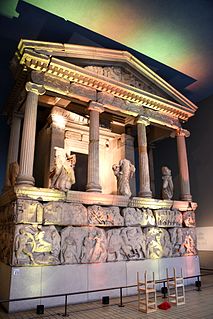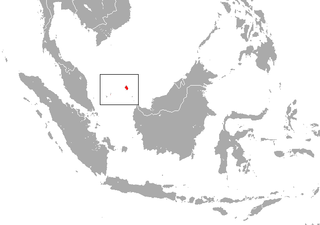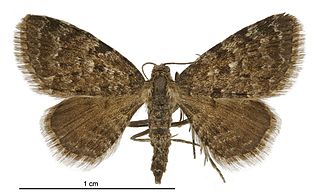
In Greek mythology, the Nereids are sea nymphs, the 50 daughters of Nereus and Doris, sisters to their brother Nerites. They often accompany Poseidon, the god of the sea, and can be friendly and helpful to sailors.
In Greek mythology, Panopea, also Panopaea, and Panope were two of the Nereids. Panope is also the name of one of the daughters of Thespius and Megamede. She bore Heracles a son, Threpsippas.

Nereis is a genus of polychaete worms in the family Nereididae. It comprises many species, most of which are marine. Nereis possess setae and parapodia for locomotion. They may have two types of setae, which are found on the parapodia. Acicular setae provide support. Locomotor chaetae are for crawling, and are the bristles that are visible on the exterior of the Polychaeta. They are cylindrical in shape, found not only in sandy areas, and they are adapted to burrow. They often cling to seagrass (posidonia) or other grass on rocks and sometimes gather in large groups. They are dangerous to touch giving very painful long lasting burns. Nereis worms are commonly known as rag worms or calm worms. The body is long, slender, and dorso-ventrally flattened, reaching a length of 5-30 cm. The head consists of two parts: a roughly triangular anterior lobe—the prostomium—and a posterior ring-like portion—the peristomium. The latter bears a pair of terminal tentacles, dorsally two pairs of eyes, and ventrally a pair of short two-jointed palps.

A facultative anaerobe is an organism that makes ATP by aerobic respiration if oxygen is present, but is capable of switching to fermentation if oxygen is absent.
Sorberacea were a monoorder and monofamilial class of benthic Tunicates. The single order of the class was Aspiraculata, and the single family of that order was Hexacrobylidae. In a taxonomic revision of the Tunicata in 2007, the name "Hexacrobylidae" was declared invalid and members of the family were included in the family Molgulidae in the class Ascidiacea.

Santi Nereo e Achilleo is a fourth-century basilica church in Rome, Italy, located in via delle Terme di Caracalla in the rione Celio facing the main entrance to the Baths of Caracalla. The Cardinal Priest of the Titulus Ss. Nerei et Achillei was Theodore Edgar McCarrick until his resignation from the cardinalate on 28 July 2018.

William Henry Harvey, FRS FLS was an Irish botanist and phycologist who specialised in algae.

The New Zealand fairy tern or tara-iti is a subspecies of the fairy tern endemic to New Zealand. It is New Zealand's rarest native breeding bird, with about 40 individuals left in the wild. It nests at four coastal locations between Whangarei and Auckland in the North Island. It is threatened by introduced predators, extreme storms and tides, beach activity, and waterfront development.

Nereididae are a family of polychaete worms. It contains about 500 – mostly marine – species grouped into 42 genera. They may be commonly called ragworms or clam worms.

The fairy tern is a small tern which is native to the southwestern Pacific. It is listed as "Vulnerable" by the IUCN and the New Zealand subspecies is "Critically Endangered".

The grey-backed storm petrel is a species of seabird in the austral storm petrel family Oceanitidae. It is monotypic within the genus Garrodia. It is found in Antarctica, Argentina, Australia, Chile, Falkland Islands, French Southern Territories, New Zealand, Saint Helena, South Africa, and South Georgia and the South Sandwich Islands. Its natural habitat is open seas.

The neriad horseshoe bat is a species of bat in the family Rhinolophidae.

Nereis vexillosa belongs to the phylum Annelida, a group known as the segmented worms. It is generally iridescent green and can reach 30 cm in length. It can be distinguished by the size of the upper ligules on the notopodia of the posterior region of the body. The upper ligules are much larger than the lower ligules. It is also without a collar-like structure around the peristomium.

Alitta succinea is a species of marine annelid in the family Nereididae. It has been recorded throughout the North West Atlantic, as well as in the Gulf of Maine and South Africa.

The Nera Gorge-Beușnița National Park is a protected area situated in Romania, in Caraş-Severin County.

Chloroclystis nereis is a moth in the family Geometridae. It was described by Edward Meyrick in 1888. It is endemic to New Zealand. The habitat consists of mountainous areas.

Hediste diversicolor, commonly known as a ragworm, is a polychaete worm in the family Nereidae. It lives in a burrow in the sand or mud of beaches and estuaries in intertidal zones in the north Atlantic. This species is used in research but its classification is in dispute and in the literature it is often classified as Nereis diversicolor. Its specific name "diversicolor" refers to the fact that its colour changes from brown to green as the breeding season approaches.

Pelagornis sandersi is an extinct species of flying bird, whose fossil remains date from 25 million years ago, during the Chattian age of the Oligocene. The sole specimen of P. sandersi has a wingspan estimated between 6.1 and 7.4 m, giving it the largest wingspan of any flying bird yet discovered, twice that of the wandering albatross, which has the largest wingspan of any extant flying bird.

Cap Island Conservation Park is a protected area in the Australian state of South Australia located about 7.5 kilometres (4.7 mi) offshore, west of Mount Misery, Eyre Peninsula. The park covers Cap Island's 8ha surface. The island consists of a granite base and a calcarenite mantle; its margins steeply over-hanging and eroded. Typical vegetation is a low Nitre Bush shrubland. Cap Island Conservation Park was constituted by statute in 1972 to conserve a sea bird breeding area and Australian Sea-lion and New Zealand Fur-seal haul-out areas.

Labeobarbus sandersi is a species of ray-finned fish in the genus Labeobarbus is found from southern Cameroon to the Chiloango River in Cabinda.
















